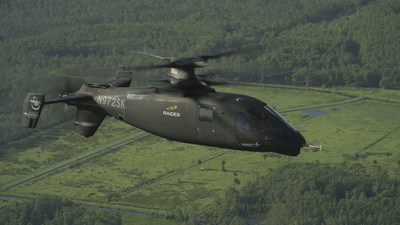Sikorsky's self-funded X2 Technology is backbone of company's next generation helicopters
WEST PALM BEACH, Fla., Oct. 4, 2018 /PRNewswire/ -- The Sikorsky S-97 Raider light tactical prototype helicopter is advancing rapidly through its flight test schedule, recently exceeding 200 knots at the Sikorsky Development Flight Center. Raider, developed by Sikorsky, a Lockheed Martin (NYSE: LMT) company, is based on the company's proven X2 Technology, enabling speeds twice that of conventional helicopters.
View the latest Sikorsky S-97 Raider video.

"The Sikorsky S-97 Raider flight test program is exceeding expectations, demonstrating Raider's revolutionary speed, maneuverability and agility," said Tim Malia, Sikorsky director, Future Vertical Lift Light. "X2 Technology represents a suite of technologies needed for the future fight, enabling the warfighter to engage in high-intensity conflict anytime, anywhere as a member of a complex, multi-domain team."
Sikorsky continues to demonstrate the application of its X2 Technology as the company prepares its proposal for the U.S. Army's Future Attack Reconnaissance Aircraft (FARA) competition, driving forward the Army's efforts to revolutionize its aircraft fleet as part of what is known as Future Vertical Lift.
Raider incorporates the latest advances in fly-by-wire flight controls, vehicle management systems and systems integration. The suite of X2 Technologies enables the aircraft to operate at high speeds while maintaining the low-speed handling qualities and maneuverability of conventional single main rotor helicopters.
"It's exciting to achieve these high speeds with X2 Technology," said Sikorsky experimental test pilot Bill Fell, a retired U.S. Army pilot. "It's undeniably important for the warfighter to get to the mission fast. And once they get there, X2 Technology provides the critical handling qualities that make the aircraft survivable, lethal and agile. Sikorsky X2 Technology changes the way we fly and fight – we can get there fast, be more effective while on the scene and we can get out fast."
Sikorsky's X2 Technology at the heart of the Raider helicopter is scalable to a variety of military missions including light assault, light attack, armed reconnaissance, close-air support, combat search and rescue and unmanned applications.
The development of X2 Technology and the Raider program has been funded entirely by significant investments by Sikorsky, Lockheed Martin and industry partners.
For more information, visit www.lockheedmartin.com/raider.
About Lockheed Martin
Headquartered in Bethesda, Maryland, Lockheed Martin is a global security and aerospace company that employs approximately 100,000 people worldwide and is principally engaged in the research, design, development, manufacture, integration and sustainment of advanced technology systems, products and services. This year the company received three Edison Awards for ground-breaking innovations in autonomy, satellite technology and directed energy.
SOURCE Lockheed Martin
https://news.lockheedmartin.com/2018-10-04-Sikorsky-S-97-Raider-Exceeds-200-Knots-as-Company-Prepares-Proposal-for-U-S-Armys-Future-Attack-Reconnaissance-Aircraft

